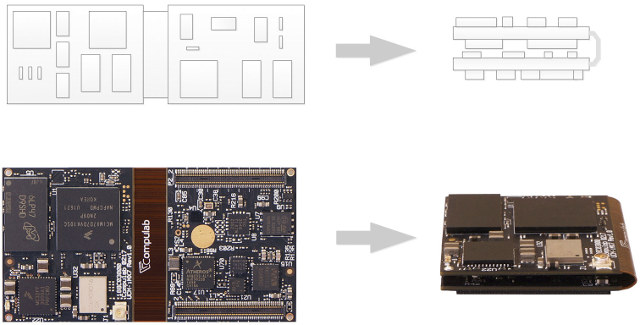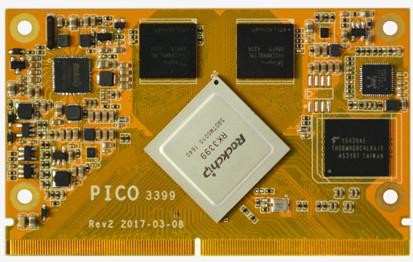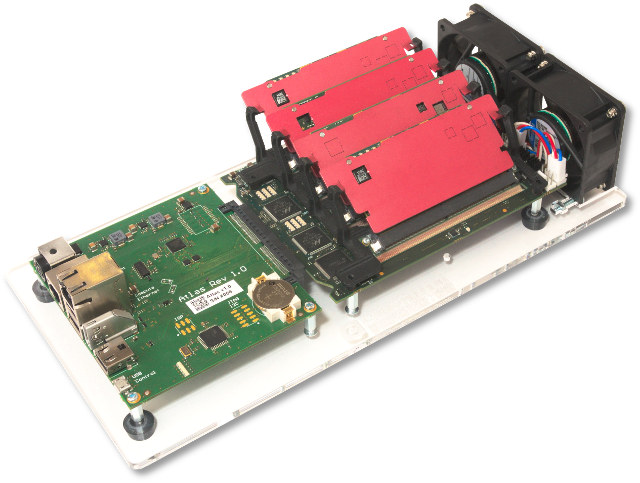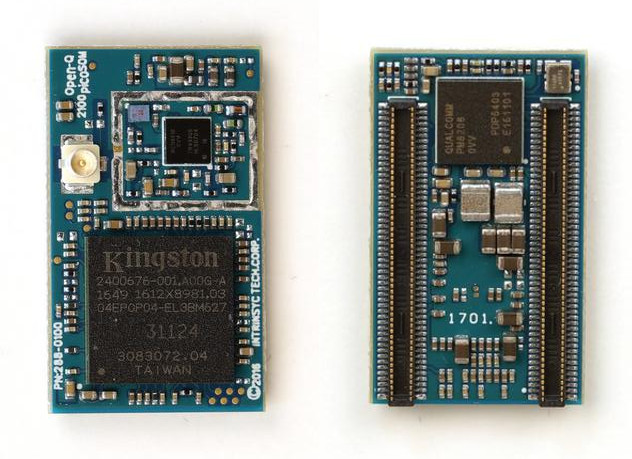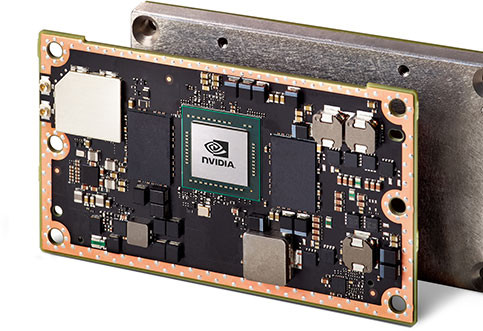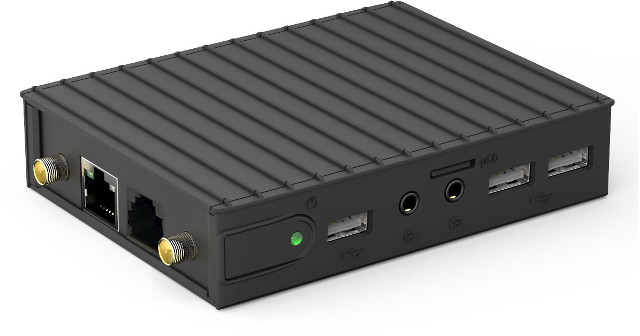Many companies are still releasing NXP – soon to be Qualcomm – i.MX 6/7 system-on-modules, but I don’t cover all of them, since we have already many to choose from. But Compulab’s latest UCM-iMX7 SoM differentiates itself by it size, using the company’s “Ultra-compact Multilevel Module” (UCMM) technology, to pack NXP i.MX7 processor, 2GB RAM, 64 GB eMMC flash, and a wireless module into a 30 x 27 x 8 mm volume that could potentially fit into something as small as a watch. The picture above clearly shows how UCMM technology works with the module comprised of two rigid PCBs and one flexible layer routing signals between the two allowing to bend and fold the rigid parts together to form a vertical stack. The principle could be extended to more PCBs and flexible layers, sof for example you could have four PCBs with three flexible layers in future / custom […]
Boardcon Introduces Rockchip RK3399 PICO3399 CPU Module and EM3399 Baseboard
There’s a limited number of boards based on Rockchip RK3399 processor, with the easiest to work with (for non-Chinese readers) probably being Firefly-RK3399. Shenzhen Xunlong is working on their own Orange Pi RK3399 board, 9Tripod released their X3399 SoM and devkit, Boardcon has also launched their own RK3399 SoM (system-on-module) and baseboard solution with respectively PICO3399 CPU module and EM3399 board. PICO3399 SoM specifications: SoC – Rockchip RK3399 hexa core processor with a dual ARM Cortex-A72 core cluster @ up to 2.0 GHz, quad ARM Cortex-A53 cluster, and ARM Mali-T860MP4 GPU System Memory – 4GB LPDDR3 Storage – 8GB eMMC flash 314-pin edge connector with 2x USB2.0 Host, 2x USB3.0 or 2x Type-C, UART, MIPI, GbE, HDMI in&out, Audio, I2C, I2S, PCI-E, SD/MMC/SDIO, GPIO, eDP.. Power Supply – 5V Dimensions – 82 x 50mm (8 layers) The company provides support for Android6.0.1 and Debian for the module. If the info […]
Getting Started with OpenCV for Tegra on NVIDIA Tegra K1, CPU vs GPU Computer Vision Comparison
This is a guest post by Leonardo Graboski Veiga, Field Application Engineer, Toradex Brasil Introduction Computer vision (CV) is everywhere – from cars to surveillance and production lines, the need for efficient, low power consumption yet powerful embedded systems is nowadays one of the bleeding edge scenarios of technology development. Since this is a very computationally intensive task, running computer vision algorithms in an embedded system CPU might not be enough for some applications. Developers and scientists have noticed that the use of dedicated hardware, such as co-processors and GPUs – the latter traditionally employed for graphics rendering – can greatly improve CV algorithms performance. In the embedded scenario, things usually are not as simple as they look. Embedded GPUs tend to be different from desktop GPUs, thus requiring many workarounds to get extra performance from them. A good example of a drawback from embedded GPUs is that they are […]
Christmann RECS|Box Atlas Quad Apalis Microserver Evaluation Kit Supports Four Toradex Apalis SoM
System-on-modules are normally used in low volume embedded systems, but they can also be used in microservers, for example to upgrade capacity as needed. Christmann informationstechnik + medien GmbH has developed a microserver evaluation kit taking up to 4 Toradex Apalis SoMs for example based on Nvidia Tegra K1 processor, and also offers full rack systems with up to 72 modules. Christmann RECS|Box Atlas Quad Apalis specifications: Modules – 4x Slots for Apalis SoM Connectivity – 1 GBit/s Compute Ethernet, 1 GBit/s Management Ethernet Video Output – 1x HDMI USB – 3x USB host ports, 1x micro USB port Misc – 5 Status LEDs for USB, communication, and serial console, 4x fan connectors, KWM switch, 5x temperature sensors, 6x current sensors, 1x voltage monitor, fan speed monitoring Power Supply – 12V via a 4-pin jack Dimensions – 300 x 145 x 68 mm The evaluation kit includes an Atlas board […]
Intrinsyc Introduces Open-Q 2100 SoM and Devkit Powered by Qualcomm Snapdragon Wear 2100 SoC for Wearables
Qualcomm unveiled Snapdragon Wear 2100 SoC for wearables early last year, and since then a few smartwatches powered by the processor – such as LG Watch Style and Watch Sport – have been launched, and Intrinsyc has now unveiled one of the first module based on the processor with Open-Q 2100 system-on-module, and a corresponding Nano-ITX baseboard. Open-Q 2100 SoM specifications: SoC – Qualcomm Snapdragon Wear 2100 (APQ8009W) quad core ARM Cortex A7 processor @ up to 1.094 GHz with Adreno 304 GPU System Memory – 512 MB LPDDR3 Storage – 4GB eMMC flash Connectivity – 802.11 b/g/n WiFi (WCN2320), Bluetooth 4.1 LE, Gen 8C GNSS (GPS/GLONASS) with on-board u.FL connector (WGR7640) Audio – Integrated Codec/PMIC (PM8916-1) with optional support for Fluence HD, Snapdragon Voice Activation, and Snapdragon Voice+ 2x 100-pin board-to-board connectors with USB 2.0, I2S, GPIO, MIPI DSI up to 720p @ 60 Hz, 2-lane MIPI CSI, SDC2/microSD […]
MYiR Tech MYC-JA5D2X System-on-Module is Powered by Microchip ATSAMA5D2 Cortex A5 Processor
MYIR Tech has released MYC-JA5D2X system-on-module powered by a Microchip Atmel SAMA5D2 ARM Cortex A5 processor with 256MB flash, and 256 MB DDR3. The module relies on a SO-DIMM edge connector to expose the camera interface, Ethernet, USB, camera, and other I/O signals. MYC-JA5D2X CPU module specifications: SoC – Atmel SAMA5D26 or SAMA5D27 ARM Cortex A5 processor @ up to 500 MHz with 128KB L2 cache System Memory – 256MB DDR3 SDRAM Storage – 256MB NAND flash, 4MB data flash, 64KB EEPROM Connectivity – On-board 10/100M Ethernet PHY 200-pin SO-DIMM edge connector with: 1x Ethernet 1x USB Host, 1x USB Device, 1x USB HSIC (HSIC is only for SAMA5D27) Up to 10x serial ports, up to 2 x CAN (only for SAMA5D27) Up to 7 x I2C, up to 7 x SPI Up to 2 x QSPI 12 x 12-bit ADC (enhanced resolution up to 14 bits) 4x PWM 1x […]
NVIDIA Introduces Jetson TX2 Embedded Artificial Intelligence Computer
NVIDIA has just announced an upgrade to to their Jetson TX1 module, with Jetson TX2 “Embedded AI Computer” with Tegra X2 Parker SoC that either doubles the performance of its predecessor, or runs at more than twice the power efficiency, while drawing less than 7.5 watts of power. The company provided a comparison showing the differences between TX1 and TX2 modules. Jetson TX2 Jetson TX1 GPU NVIDIA Pascal, 256 CUDA cores NVIDIA Maxwell, 256 CUDA cores CPU HMP Dual Denver 2/2 MB L2 + Quad ARM® A57/2 MB L2 Quad ARM® A57/2 MB L2 Video 4K x 2K 60 Hz Encode (HEVC) 4K x 2K 60 Hz Decode (12-Bit Support) 4K x 2K 30 Hz Encode (HEVC) 4K x 2K 60 Hz Decode (10-Bit Support) Memory 8 GB 128 bit LPDDR4 58.3 GB/s 4 GB 64 bit LPDDR4 25.6 GB/s Display 2x DSI, 2x DP 1.2 / HDMI 2.0 / […]
Compulab IOT-GATE-iMX7 is an NXP i.MX7 IoT Gateway for Industrial Applications
CompuLab has introduced IOT-GATE-iMX7 compact fanless IoT gateway and industrial controller built around the company’s CL-SOM-iMX7 system-on-module, and offering Ethernet, WiFi, Bluetooth, 3G and Zigbee connectivity.Compulab IOT-GATE-iMX7 gateway specifications: SoC – NXP i.MX 7 dual ARM Cortex-A7 processor @ up to 1GHz with ARM Cortex-M4 core @ 200Mhz, 2D graphics engine System Memory – Up to 2GB DDR3L-1066 Storage – Up to 32GB on-board eMMC + micro-SD socket Connectivity Dual Gigabit Ethernet Dual band WiFi 802.11 a/b/g/n Bluetooth 4.1 BLE Optional 3G cellular module via mini PCie socket Optional ZigBee NXP JN5168 module Display – DVI up to 1920×1080 using a HDMI connector Audio – 3.5mm jacks for stereo line out, stereo line in USB – 4x USB2.0 host ports, type-A connectors Serial – 1x RS485 / RS422 port, RJ11 connector; 1x RS232 port, ultra-mini serial connector; 1x serial console via UART-to-USB bridge, micro-USB connector Expansion mini-PCIe socket, full-size embedded […]


